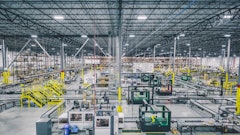
When we think of receiving goods or purchasing items from the grocery store, we don’t think about the journey of those items from their respective origins to their destination. But those who specialize in cargo theft, do. In fact, they are plotting the perfect time to intercept those shipments.
As a result, cargo thefts are on the rise, sending many companies wondering how to defend themselves. In the span of two years, reports of cargo theft have skyrocketed, with 1,183 reported incidents in 2023 alone, resulting in a loss of $694 million in stolen goods. These numbers emphasize the need for retailers to boost their security measures to adapt to the evolving tactics of those plotting theft.
The food, beverage, and cold food chain sector are also affected by this rise and the difference is that the cargo they carry contains perishable goods. Perishable goods require precise temperature-controlled environments, so any hiccup in transit could lead to financial losses and worse, spoiled food. This has companies searching for solutions that will protect their cargo and help maintain trust in their supply chains.
Defining cargo theft
Cargo theft is the unlawful transport of stolen goods at any point during the transportation journey. This can include goods, chattels, money or baggage. As it relates to the food and beverage industry, this includes perishable goods that usually have to be in temperature-controlled environments. When a shipment containing these goods is lost, it can have daunting effects on a company’s financial status and overall reputation, which ultimately impacts consumers who buy these goods.
Understanding the challenge
Reports indicate that the average loss per cargo theft incident skyrocketed by 67% in 2023 compared to the previous year, with projections indicating a further 35% surge in 2024. This threatens retailers and means higher prices for consumers that they serve.
Perishable foods require special security because of the temperature-controlled environments they require. How do companies rewire their security protocols to alleviate risks and protect their cargo?
Challenges specific to the cold food chain sector
Perishable goods require more attention during the shipping process not only because they can spoil but because consumers need products and retailers they can trust. For that reason, these shipments must be monitored with precision and care. These goods have to account for:
- Temperature sensitivity, Perishable goods are extremely sensitive to temperature changes, especially meat, dairy or similar. Changes in the shipping process can compromise the quality and safety of the products, making them unsuitable to eat or drink.
- Time sensitivity. Unlike non-perishable goods, perishable food and beverage products have a limited shelf life and must be delivered within a specific timeframe. Any delays can lead to spoiled food, resulting in financial losses for producers and retailers.
Potential solutions
- Advanced temperature monitoring. These systems utilize cutting-edge technology to track temperature conditions of goods from their shipping destination to final delivery points. They provide real-time insights into temperature changes accompanied by automated alerts that can notify relevant personnel.
- Secure packaging and handling. Companies can also use tamper-evident seals and secure packaging for an extra layer of protection. Tamper-evident seals are designed to indicate to suppliers if a package has been tampered with or opened without authorization, which will show those handling shipments, whether or not there have been potential breaches.
- Enhanced supply chain visibility. Advanced tracking technologies such as Radio Frequency Identification (RFID) tags, barcodes, and serial numbers can be integrated into current processes to track the movement of products at every stage.
But many suppliers are facing challenges that go even further beyond securing their cargo. They are also faced with challenges in verifying carrier credentials. This is due to:
● Complex supply chains. The transportation industry operates in a complex network of carriers, subcontractors, and third-party vendors. Verifying carrier credentials can be challenging, leaving companies vulnerable to cargo theft.
● Limited transparency. Traditional methods of verifying carrier credentials rely on manual documentation and paperwork. This lack of transparency negates efforts to validate whether or not transportation partners are legitimate.
Advanced tracking technologies allow suppliers to stay ahead of the curve and enhance the security of their supply chains. These tracking technologies take on the form of:
- Smart data analytics. This enables companies to analyze large amounts of data in real-time. They are then able to identify patterns or abnormalities that may indicate potential security threats. This way they can lower risk of theft and enhance their visibility across the supply chain.
- GPS tracking and real-time monitoring. Using GPS tracking systems and real-time monitoring solutions gives companies visibility into the whereabouts of their shipments. This real-time insight allows them to react quickly to security breaches or suspicious activity.
Protecting the goods of suppliers in the food and beverage and cold food chain vector won’t be easy. But with strategic planning and implementation of advanced methods, suppliers can protect themselves from widespread cargo theft.


























